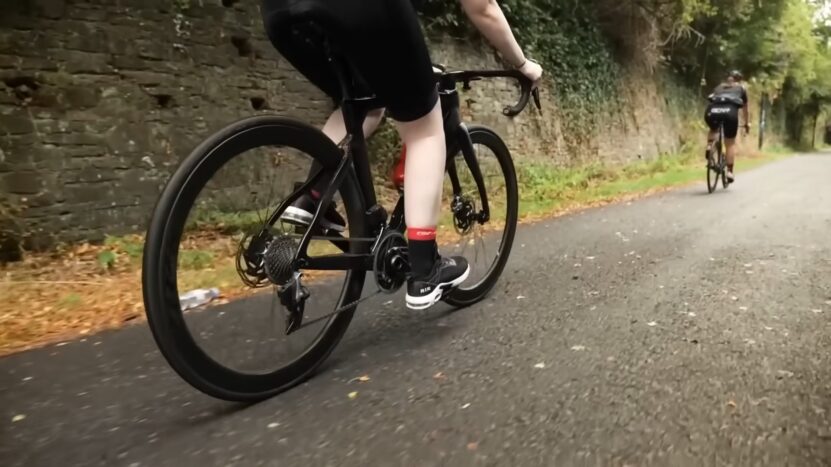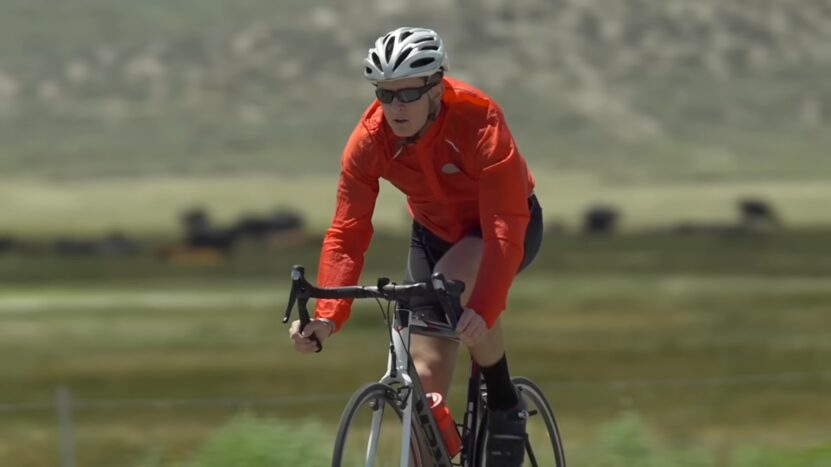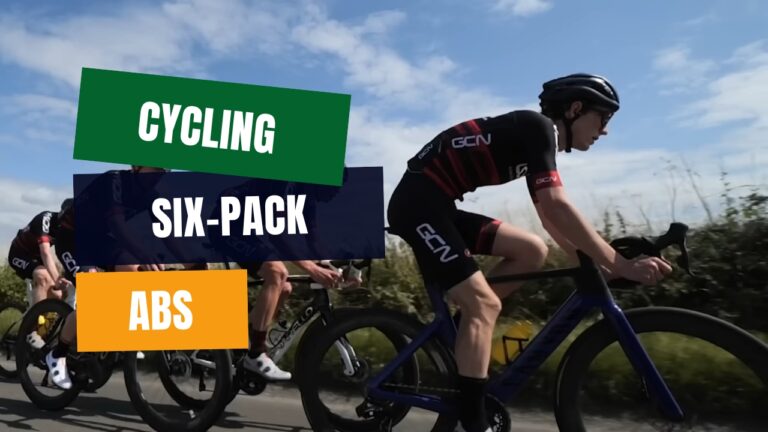We’ve all heard the saying, “Abs are made in the kitchen.” While that’s undeniably true, there are methods to assist us om the quest for a chiseled midsection, among them cycling.
Picture this: you’re on your bike, pedaling away, feeling the wind on your face. But did you know that with every pedal stroke, your abdominal muscles are firing up, working tirelessly to keep you balanced and stable? That’s right, cycling is not just about the legs; it’s a full-core workout.
And the best part? As you’re enjoying the ride, you’re also burning calories and melting away that layer of fat that might be hiding your soon-to-be-revealed six-pack.
Does Cycling Give You Abs

Absolutely! Cycling is a fantastic way to help sculpt those abdominal muscles. When you’re on a bike, you’re not just working your legs. Your core, which includes your abs, is actively engaged to maintain balance, good posture, and power. This multi-angle engagement is precisely what the abdominal muscles need to tone up. Plus, cycling is easy on the joints and spine, making it a sustainable choice for many.
Remember, though, like any exercise, it’s essential to start with a good warm-up and finish with a cool-down to prevent any injuries. And if you’re keen on amplifying the abdominal benefits, throw in some challenging terrains like hills or quick sprints during your ride.
In essence, if a toned midsection is on your wishlist, cycling can be your best friend. Just ensure you’re consistent, focused on your form, and those miles will translate into visible results.
Can You Get a Six-Pack from Cycling?
The answer is a resounding yes! But, as with any fitness goal, it’s a blend of dedication, time, and effort. Cycling alone can work wonders for your core, but to truly unveil that six-pack, it’s crucial to incorporate a balanced diet and specific corea exercises.
Every time you pedal, your abs are at play, working hard to stabilize and balance your body. This consistent engagement is a ticket to strengthening and toning the muscles in your midsection. However, to truly see the fruits of your labor, consistency is key. Aim for at least three 30-minute cycling sessions a week.
Of course, no fitness goal is complete without the right nutrition. For that six-pack to shine, focus on a diet rich in lean proteins, healthy fats, and an abundance of fruits and vegetables. Steer clear of processed foods, limit sugary beverages, and watch your alcohol intake.
In conclusion, while cycling is a powerful tool in your six-pack arsenal, it’s the combination of consistent rides, targeted core workouts, and a balanced diet that will bring those abs to the forefront. Stay dedicated, be patient, and soon enough, you’ll be flaunting that chiseled midsection!
Can Cycling Help in Flat Stomach
Absolutely! Cycling is a fantastic way to work towards that flat stomach many of us desire. When you’re on your bike, it’s not just your legs doing the heavy lifting. Your abdominal muscles are actively engaged in the process. The act of pedaling requires your abs to stabilize your body, ensuring you remain upright and balanced. This consistent engagement helps tone and strengthen your core muscles.
Moreover, cycling is an effective calorie burner. Those intense rides, especially if you throw in some hills or sprints, can help shed the belly fat that might be covering your toned abdominal muscles.
Will Biking Make Me Skinny?
Biking is undeniably a wonderful cardiovascular exercise. It gets your heart pumping, lungs working, and yes, it can help you burn those pesky calories. But will it magically make you skinny? Well, it’s a bit more nuanced than a simple yes or no.
Weight loss is a combination of many factors, with diet playing a pivotal role. You’ve probably heard the saying, “You can’t out-exercise a bad diet,” and there’s a lot of truth to that. While biking can help you create a calorie deficit, if you’re consuming more calories than you’re burning, you might not see the weight loss results you’re hoping for.
However, if you combine regular biking with a balanced, nutritious diet, you’re on the right track. Over time, with consistency, you might start to notice a positive change in your physique. But remember, everyone’s body is different, and weight loss isn’t linear. It’s essential to focus on the journey, enjoy the ride (literally!), and celebrate the small victories along the way.
This way, you can seamlessly transition from a heart-pumping bike ride to a calming yoga session, ensuring you get the best of both worlds in your fitness routine.
Is It OK To Ride Bike Every Day?
Absolutely! Hopping on your bike daily can be a fantastic decision for both your physical and mental health. Let’s break down some of the benefits:
- Calorie Burner: A mere 30 minutes of cycling can torch up to 200 calories. So, if you’re aiming to shed some pounds or maintain your current weight, cycling can be a valuable ally.
- Heart Health: Cycling gets your heart pumping, which can lead to improved cardiovascular health. Regular biking can help elevate your heart rate and, over time, can contribute to lowering blood pressure.
- Mental Boost: Ever heard of the “runner’s high”? Well, cyclists can experience something similar. The combination of fresh air, physical activity, and the joy of riding can significantly uplift your mood and reduce stress.
In essence, daily biking can be a boon for your overall well-being. Whether you’re commuting, exercising, or just riding for the sheer joy of it, the benefits are plentiful. So, strap on that helmet and pedal away!
Is Cycling Good For Your Butt?

Indeed, cycling can be your secret weapon for a toned derrière. When you’re on your bike, especially when tackling higher gears or uphill terrains, your glutes (the muscles in your butt) are engaged intensely. This continuous engagement helps in toning and strengthening the glutes.
Moreover, cycling is a comprehensive lower-body workout. So, while your butt is getting a good workout, your thighs, calves, and even your core are being toned. The low-impact nature of cycling also means it’s kinder on your joints compared to high-impact exercises.
In short, if a toned butt is on your fitness wishlist, cycling can be a fantastic way to achieve it. Combine it with some targeted strength training exercises, and you’ll be on your way to a firmer, stronger backside.
Does Biking Make Your Butt Bigger?
A common misconception is that biking might enlarge your butt. However, the reality is quite the opposite. Cycling is an excellent way to tone and shape the muscles in your glutes, giving you a firmer and more defined posterior. So, if you’ve been hesitant about hopping on a bike fearing it might add volume to your behind, you can put those worries to rest.
Remember, comfort is key when cycling. Wearing the right attire, especially padded cycling shorts, can prevent any unwanted friction and make your rides more enjoyable.
Are 60 Minutes of Cycling a Day Enough?
Absolutely! Committing to 60 minutes of cycling daily can be a game-changer for your health and fitness. This duration not only aids in calorie burning and metabolism boosting but also offers a refreshing break from indoor routines, allowing you to breathe in some fresh air and explore new terrains.
However, everyone’s fitness journey is unique. If you’re aiming for more intense results, consider spicing up your cycling routine. Incorporating interval training or challenging yourself with hill climbs can elevate the intensity, pushing you closer to your fitness goals.
So, if you’re contemplating whether an hour of cycling is worth it, the answer is a resounding yes. It’s a balanced blend of cardio, muscle toning, and mental relaxation.
Is Cycling a Full-Body Workout?

While it’s easy to associate cycling primarily with leg work, it’s genuinely a holistic exercise. Here’s a breakdown:
- Arms & Shoulders: Holding onto the handlebars and maneuvering the bike engages your biceps, triceps, and deltoids.
- Core: Your abdominal muscles are constantly at play, ensuring you remain balanced and upright on the bike.
- Legs & Glutes: The act of pedaling is a rigorous workout for your calves, quads, hamstrings, and, of course, the glutes.
- Cardiovascular System: Cycling gets your heart rate up, promoting better heart health and endurance.
What Body Parts Benefit From Cycling?
Cycling, often seen as a leg-centric activity, actually offers a plethora of benefits to various parts of the body. Let’s delve into the specific body parts that reap the rewards of regular cycling:
- Heart: One of the primary beneficiaries, cycling enhances cardiovascular health, promoting better circulation and reducing the risk of heart diseases.
- Lungs: As a cardio exercise, cycling boosts lung capacity, ensuring better oxygen distribution throughout the body.
- Leg Muscles: The most obvious beneficiaries are the leg muscles. Quadriceps, hamstrings, and calves get toned and strengthened with regular pedaling.
- Joints: Especially the knee joints. Cycling, being a low-impact exercise, ensures that the joints remain lubricated, reducing the risk of arthritis.
- Back and Shoulders: Maintaining an upright posture while cycling strengthens the back and shoulder muscles, potentially reducing back pains and improving posture.
- Brain: Mental health gets a boost with cycling. It aids in reducing stress, anxiety, and even depression. The increased blood flow to the brain can enhance cognitive functions and memory.
In essence, cycling is a holistic exercise, benefiting both the mind and multiple body parts, making it an excellent choice for overall well-being.
Is Cycling 2 Hours a Day Too Much?
Cycling for two hours daily can be both beneficial and excessive, depending on various factors:
- Intensity: If you’re cycling at a moderate pace, two hours can be manageable. However, if you’re pushing yourself hard every day for that duration, it might lead to overtraining.
- Experience: Seasoned cyclists might find two hours daily to be within their comfort zone. But for beginners, it’s essential to gradually increase the duration to avoid injuries.
- Recovery: The body needs time to recover after any exercise. If after two hours of cycling daily you feel fatigued, sore, or notice a decrease in performance, it might be a sign to dial it back a bit.
- Purpose: If you’re training for a competition, long daily rides might be part of your regimen. However, for general fitness, it’s crucial to balance cycling with other forms of exercise to ensure a well-rounded fitness routine.
Conclusion
Cycling, a seemingly simple activity, offers a myriad of benefits that extend beyond just physical fitness. From enhancing cardiovascular health to boosting mental well-being, the advantages of incorporating cycling into one’s routine are vast.
While the duration and intensity should be tailored to individual needs and goals, it’s undeniable that cycling stands as a holistic exercise suitable for all ages. Whether you’re pedaling towards a competitive goal or simply for the joy of feeling the wind against your face, cycling promises a journey that’s as rewarding as the destination.
So, strap on that helmet, hit the road, and embrace the multifaceted benefits of this timeless activity.

